Grow Dragon Fruit at Home? Absolutely! Imagine plucking a vibrant, exotic dragon fruit straight from your own backyard. Sounds like a tropical dream, right? Well, it’s more attainable than you think! For centuries, dragon fruit, also known as pitaya, has been cultivated in Southeast Asia and Latin America, prized not only for its unique appearance but also for its delicious, subtly sweet flavor and impressive health benefits.
I know what you’re thinking: “That sounds complicated!” But trust me, with a few simple tricks and a little DIY spirit, you can successfully grow dragon fruit at home, even if you don’t have a sprawling orchard. This guide is packed with easy-to-follow instructions and clever hacks that will transform your garden (or even your balcony!) into a thriving dragon fruit oasis.
Why should you bother? Because store-bought dragon fruit can be expensive and sometimes lacks the freshness and flavor of homegrown varieties. Plus, there’s nothing quite like the satisfaction of nurturing a plant from a small cutting to a fruit-bearing beauty. So, let’s ditch the grocery store and embark on this exciting gardening adventure together! Get ready to learn the secrets to cultivating these stunning fruits and enjoy the rewards of your labor.
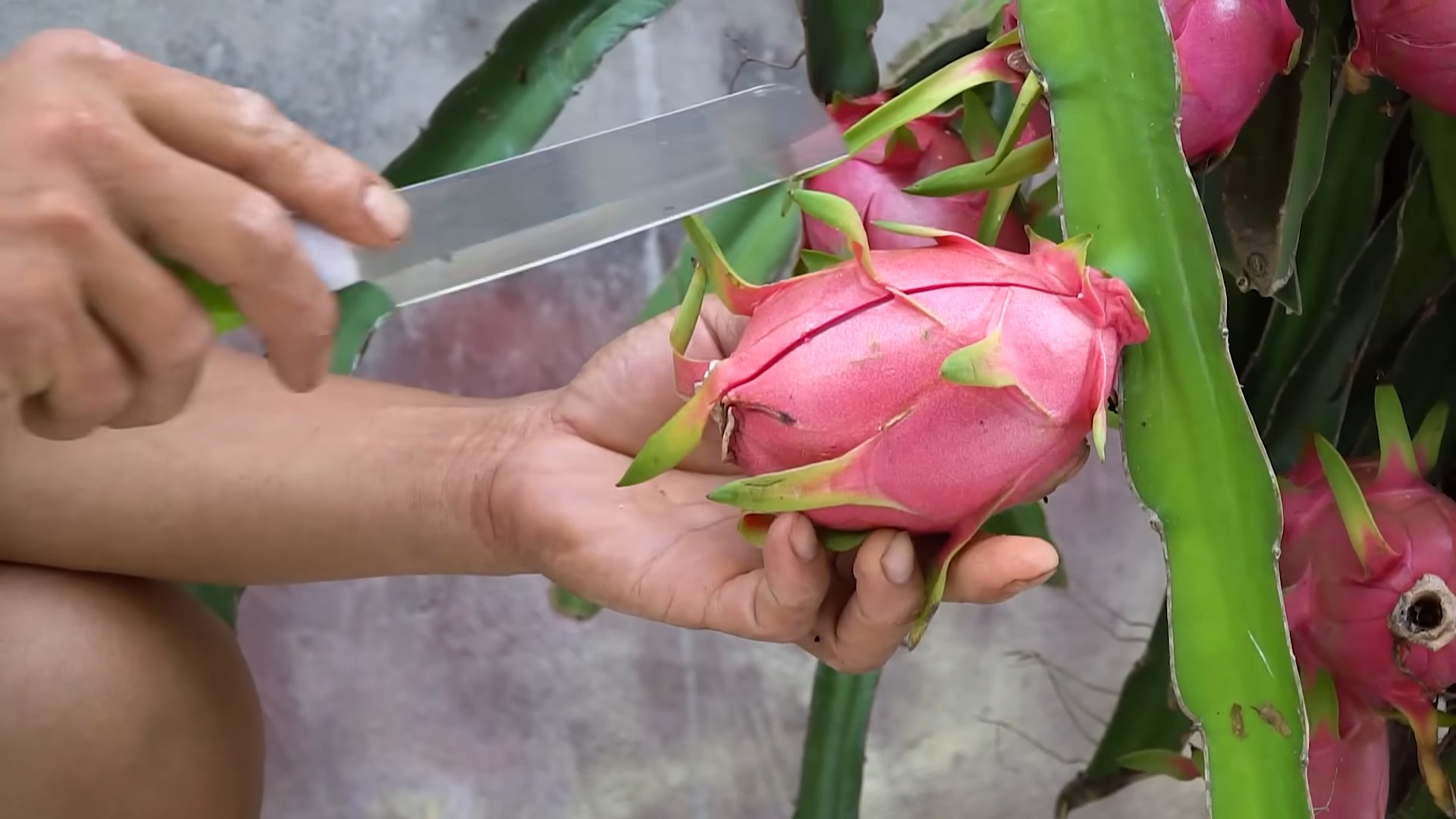
Growing Dragon Fruit at Home: A Complete DIY Guide
Hey there, fellow plant enthusiasts! Ever dreamt of having your own exotic dragon fruit growing right in your backyard (or even indoors)? Well, dream no more! I’m here to guide you through the entire process, from choosing the right variety to harvesting your delicious, homegrown dragon fruit. It might seem intimidating at first, but trust me, with a little patience and the right information, you can totally do this!
Choosing Your Dragon Fruit Variety
Before we dive into the nitty-gritty, let’s talk about varieties. Dragon fruit comes in several types, each with its own unique flavor, color, and growth habits. Here’s a quick rundown to help you choose the best one for your needs:
* White-fleshed varieties (e.g., ‘Hylocereus undatus’): These are the most common and readily available. They have a mild, slightly sweet flavor and are a great starting point for beginners.
* Red-fleshed varieties (e.g., ‘Hylocereus costaricensis’): These are known for their vibrant red flesh and slightly tart flavor. They’re also packed with antioxidants!
* Pink-fleshed varieties (e.g., ‘Hylocereus polyrhizus’): These offer a sweet and refreshing flavor, somewhere between the white and red varieties.
* Yellow-fleshed varieties (e.g., ‘Selenicereus megalanthus’): These are considered the sweetest and most flavorful of all dragon fruit varieties. However, they can be a bit more challenging to grow.
Things to consider when choosing a variety:
* Climate: Some varieties are more cold-hardy than others. If you live in a colder climate, opt for a more resilient variety.
* Taste preference: Do you prefer sweet or tart? White, red, pink, or yellow flesh?
* Availability: Some varieties are harder to find than others. Check with your local nurseries or online retailers.
Once you’ve chosen your variety, it’s time to get started!
Getting Started: Propagation and Planting
You can start your dragon fruit journey in a couple of ways: from seed or from cuttings. I personally prefer cuttings because they’re faster and more reliable.
Propagating from Cuttings
1. Obtain a healthy cutting: Ask a friend, neighbor, or local nursery for a cutting from a mature dragon fruit plant. The cutting should be at least 12 inches long and healthy-looking. Make sure the cut end is clean and free of disease.
2. Let the cutting callous: This is crucial! Place the cutting in a dry, shaded area for about a week. This allows the cut end to dry and form a callus, which prevents rot.
3. Prepare your potting mix: Dragon fruit needs well-draining soil. I like to use a mix of equal parts potting soil, perlite, and coarse sand. This ensures good drainage and aeration.
4. Plant the cutting: Dip the calloused end of the cutting in rooting hormone (optional, but it helps!). Plant the cutting about 2-3 inches deep in your prepared potting mix.
5. Water lightly: Water the cutting gently, just enough to moisten the soil. Avoid overwatering, as this can lead to rot.
6. Provide support: Dragon fruit is a climbing cactus, so it needs support. Place a stake or trellis near the cutting to provide something for it to climb on.
7. Be patient: It can take several weeks for the cutting to root. Keep the soil lightly moist and provide bright, indirect light. You’ll know it’s rooted when you see new growth.
Planting Your Dragon Fruit
1. Choose the right location: Dragon fruit needs at least 6-8 hours of sunlight per day. If you’re growing it indoors, place it near a sunny window. If you’re growing it outdoors, choose a spot that gets plenty of sun but is protected from strong winds.
2. Prepare the soil: Dragon fruit prefers well-draining soil that is slightly acidic. Amend your soil with compost or other organic matter to improve drainage and fertility.
3. Dig a hole: Dig a hole that is twice as wide and as deep as the root ball of your dragon fruit plant.
4. Plant the dragon fruit: Gently remove the dragon fruit plant from its container and place it in the hole. Backfill the hole with soil and gently firm it around the plant.
5. Water thoroughly: Water the dragon fruit plant thoroughly after planting.
6. Provide support: Dragon fruit needs a strong support structure to climb on. A sturdy trellis, post, or even a large tree can work. Make sure the support is tall enough to accommodate the mature size of the plant.
7. Mulch around the base: Apply a layer of mulch around the base of the plant to help retain moisture and suppress weeds.
Caring for Your Dragon Fruit Plant
Now that your dragon fruit is planted, it’s time to learn how to care for it. Here’s what you need to know:
* Watering: Dragon fruit is drought-tolerant, but it still needs regular watering, especially during the growing season. Water deeply when the top inch of soil feels dry. Avoid overwatering, as this can lead to root rot. Reduce watering during the winter months.
* Fertilizing: Dragon fruit benefits from regular fertilization. Use a balanced fertilizer (e.g., 10-10-10) every 2-3 months during the growing season. You can also supplement with compost or other organic fertilizers.
* Pruning: Pruning is important for maintaining the shape and health of your dragon fruit plant. Remove any dead, damaged, or crossing branches. You can also prune to encourage branching and fruit production.
* Pest and disease control: Dragon fruit is relatively pest-resistant, but it can be susceptible to certain pests and diseases, such as aphids, mealybugs, and fungal infections. Inspect your plant regularly for signs of pests or diseases and take action promptly. Insecticidal soap or neem oil can be used to control pests. Fungicides can be used to treat fungal infections.
* Pollination: Most dragon fruit varieties are self-pollinating, but some may require hand-pollination to ensure fruit set. If you’re not getting fruit, try hand-pollinating the flowers. Use a small paintbrush to transfer pollen from the stamen (male part) to the pistil (female part) of the flower. Dragon fruit flowers typically bloom at night, so you’ll need to hand-pollinate them in the evening or early morning.
Harvesting Your Dragon Fruit
After all your hard work, it’s finally time to harvest your dragon fruit! Here’s how to tell when it’s ready:
* Color: The skin of the dragon fruit will turn from green to bright red, pink, or yellow, depending on the variety.
* Shape: The fruit will become plump and slightly rounded.
* Touch: The fruit will feel slightly soft to the touch.
* “Wings”: The “wings” or bracts on the fruit will start to dry out and turn brown.
To harvest your dragon fruit, simply twist it gently from the stem. If it’s ripe, it should come off easily.
Enjoying Your Homegrown Dragon Fruit
Congratulations! You’ve successfully grown your own dragon fruit. Now it’s time to enjoy the fruits of your labor. Dragon fruit can be eaten fresh, added to smoothies, or used in desserts. It’s a delicious and nutritious treat that you can be proud of growing yourself!
Some serving suggestions:
* Fresh: Simply slice the dragon fruit in half and scoop out the flesh with a spoon.
* Smoothies: Add dragon fruit to your favorite smoothie recipe for a boost of flavor and nutrients.
* Salads: Dice dragon fruit and add it to fruit salads or green salads.
* Desserts: Use dragon fruit to make sorbet, ice cream, or other desserts.
Troubleshooting Common Problems
Even with the best care, you might encounter some problems along the way. Here are some common issues and how to address them:
* Yellowing leaves: This could be a sign of overwatering, underwatering, nutrient deficiency, or pest infestation. Check the soil moisture and adjust your watering accordingly. Fertilize your plant regularly. Inspect for pests and treat as needed.
* Lack of flowering: This could be due to insufficient sunlight, lack of fertilization, or improper pruning. Make sure your plant is getting enough sunlight. Fertilize regularly. Avoid pruning too heavily.
* Fruit drop: This could be caused by poor pollination, extreme temperatures, or nutrient deficiency. Try hand-pollinating the flowers. Protect your plant from extreme temperatures. Fertilize regularly.
* Root rot: This is usually caused by overwatering. Make sure your soil is well
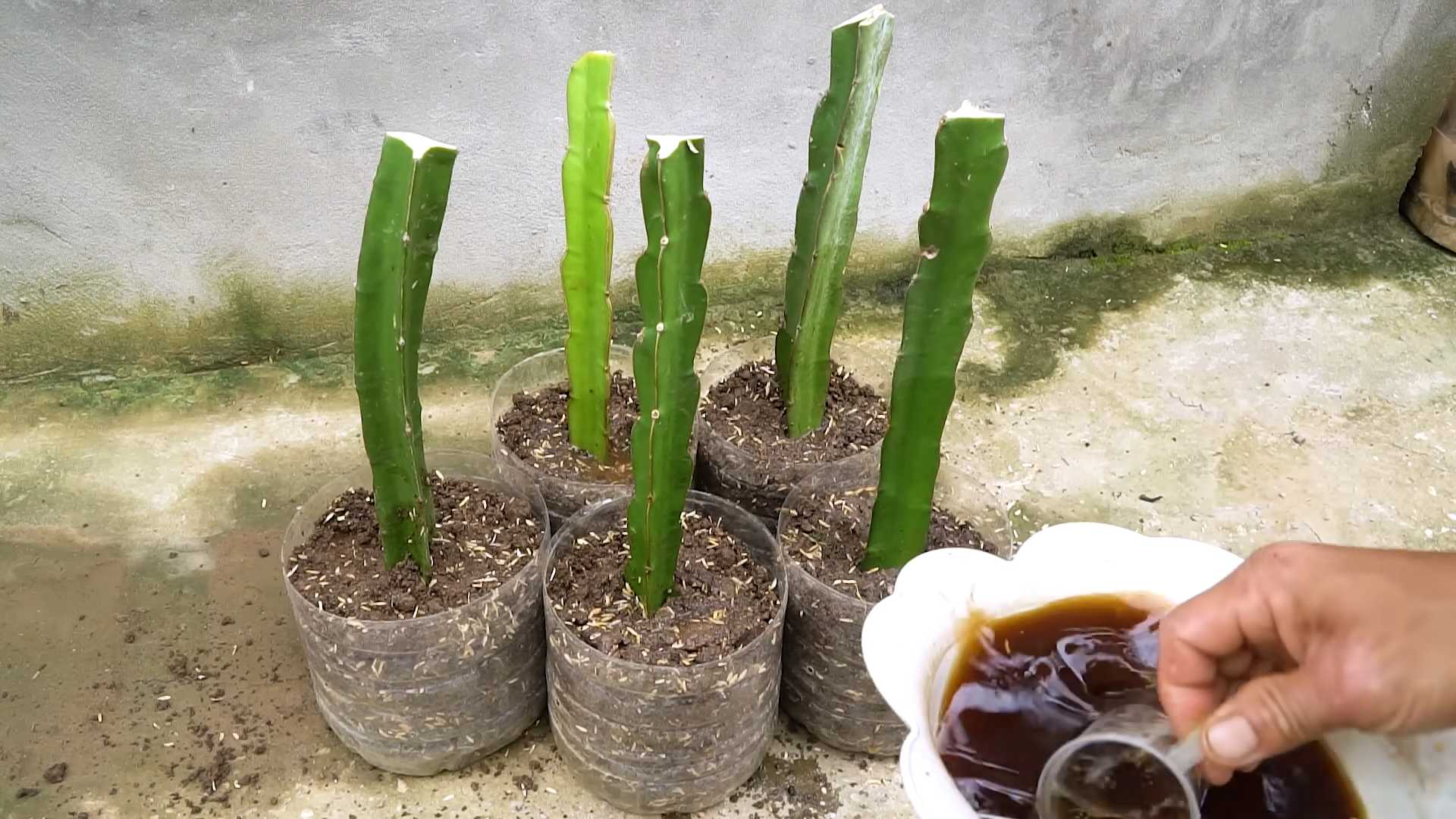
Conclusion
So, there you have it! Growing dragon fruit at home isn’t just a gardening project; it’s an adventure that rewards you with exotic, delicious fruit and a stunningly beautiful plant. We’ve walked you through the steps, from selecting the right cutting to providing the perfect support structure. But why should you actually take the plunge and try this DIY project?
Firstly, the satisfaction of harvesting your own dragon fruit is unparalleled. Imagine the look on your friends’ and family’s faces when you present them with a fruit that looks like it belongs in a tropical paradise, grown right in your own backyard (or even on your balcony!). Secondly, you have complete control over the growing process. You can ensure your dragon fruit is grown organically, free from harmful pesticides and chemicals. This means you’re not only enjoying a delicious fruit, but also a healthy one.
Thirdly, growing dragon fruit is surprisingly economical in the long run. While the initial investment in a cutting and support structure might seem a bit much, consider the cost of buying dragon fruit at the grocery store. These exotic fruits often come with a hefty price tag. With your own plant, you’ll be enjoying fresh, homegrown dragon fruit for years to come, saving money and reducing your carbon footprint.
But the real magic lies in the versatility of this project. Feel free to experiment with different varieties of dragon fruit. There are numerous cultivars available, each with its own unique flavor profile and color. Try growing a red-fleshed variety alongside a white-fleshed one for a visually stunning and flavorful harvest. You can also experiment with different support structures. While a sturdy trellis is ideal, you can also use a large pot with a central pole or even train the plant along a fence.
Don’t be afraid to get creative with your growing environment. Dragon fruit thrives in warm climates, but with proper care, you can successfully grow it in cooler regions as well. Consider using a greenhouse or bringing your plant indoors during the winter months. You can also use grow lights to supplement natural sunlight.
And finally, remember that growing dragon fruit is a learning process. Don’t be discouraged if you encounter challenges along the way. Every gardener faces setbacks, but the key is to learn from your mistakes and keep experimenting. The rewards of successfully growing your own dragon fruit are well worth the effort.
So, what are you waiting for? Grab a cutting, build a trellis, and embark on your own dragon fruit growing adventure. We’re confident that you’ll be amazed by the results. And once you’ve harvested your first dragon fruit, be sure to share your experience with us! We’d love to hear your tips, tricks, and stories. Share your photos and videos on social media using [Your Hashtag Here] and let’s create a community of dragon fruit enthusiasts. Let’s all learn how to **grow dragon fruit at home** together!
Frequently Asked Questions (FAQ)
1. What is the best time of year to plant dragon fruit?
The ideal time to plant dragon fruit is during the spring or early summer. This allows the plant to establish itself and develop a strong root system before the cooler months arrive. In warmer climates, you can plant dragon fruit year-round, but avoid planting during periods of extreme heat or cold.
2. How much sunlight does dragon fruit need?
Dragon fruit requires at least six to eight hours of direct sunlight per day. While it can tolerate some shade, insufficient sunlight will result in poor growth and reduced fruit production. If you’re growing dragon fruit indoors, supplement natural sunlight with grow lights.
3. What type of soil is best for dragon fruit?
Dragon fruit prefers well-draining soil that is rich in organic matter. A slightly acidic to neutral pH (6.0 to 7.0) is ideal. You can improve soil drainage by adding perlite or sand. Amend the soil with compost or well-rotted manure to provide essential nutrients. Avoid heavy clay soils, as they can retain too much moisture and lead to root rot.
4. How often should I water my dragon fruit plant?
Water dragon fruit regularly, especially during the growing season (spring and summer). Allow the soil to dry out slightly between waterings. Overwatering can lead to root rot, so it’s important to ensure good drainage. Reduce watering during the dormant season (fall and winter).
5. How do I fertilize my dragon fruit plant?
Fertilize dragon fruit regularly during the growing season with a balanced fertilizer. A fertilizer with a ratio of 10-10-10 or 20-20-20 is a good choice. Apply the fertilizer according to the package instructions. You can also use organic fertilizers such as compost tea or fish emulsion. Avoid over-fertilizing, as this can damage the plant.
6. How long does it take for dragon fruit to produce fruit?
Dragon fruit typically takes six to eight months to produce fruit after planting a cutting. However, this can vary depending on the variety, growing conditions, and care provided. Be patient and continue to provide proper care, and you’ll eventually be rewarded with delicious fruit.
7. How do I pollinate dragon fruit?
Most dragon fruit varieties are self-pollinating, meaning they can pollinate themselves. However, cross-pollination with another variety can increase fruit set and size. If you’re growing only one variety, you can hand-pollinate the flowers to improve fruit production. Use a small brush to transfer pollen from the stamen (male part) to the pistil (female part) of the flower.
8. What are some common pests and diseases that affect dragon fruit?
Dragon fruit is relatively pest and disease resistant, but it can be susceptible to certain problems. Common pests include aphids, mealybugs, and scale insects. These can be controlled with insecticidal soap or neem oil. Root rot is a common disease that can occur in poorly drained soil. Prevent root rot by ensuring good drainage and avoiding overwatering.
9. How do I prune my dragon fruit plant?
Pruning is important for maintaining the shape and health of your dragon fruit plant. Remove any dead, damaged, or diseased branches. Prune back long, trailing branches to encourage branching and fruit production. You can also prune the plant to control its size and shape.
10. Can I grow dragon fruit in a pot?
Yes, you can successfully grow dragon fruit in a pot. Choose a large pot with good drainage. Use a well-draining potting mix that is rich in organic matter. Provide a sturdy support structure for the plant to climb on. Water and fertilize regularly.
11. My dragon fruit plant is flowering, but not producing fruit. What could be the problem?
There are several reasons why your dragon fruit plant might be flowering but not producing fruit. Possible causes include: insufficient pollination, lack of nutrients, stress from environmental factors (such as extreme heat or cold), or the plant may be too young. Ensure proper pollination, fertilize regularly, and provide optimal growing conditions.
12. How do I know when my dragon fruit is ripe?
A ripe dragon fruit will have a vibrant, even color. The skin will be slightly soft to the touch, but not mushy. The “wings” or scales of the fruit will begin to dry out and turn brown. The fruit should also detach easily from the stem when gently twisted.
13. Can I grow dragon fruit from seed?
While it is possible to grow dragon fruit from seed, it is not recommended. Seedlings take much longer to mature and produce fruit compared to cuttings. Additionally, the fruit produced from seedlings may not be true to type, meaning it may not have the same characteristics as the parent plant.
14. What are some different varieties of dragon fruit?
There are many different varieties of dragon fruit, each with its own unique flavor, color, and size. Some popular varieties include: Hylocereus undatus (white flesh), Hylocereus costaricensis (red flesh), Hylocereus megalanthus (yellow skin with white flesh), and Hylocereus polyrhizus (red skin with red flesh). Experiment with different varieties to find your favorite.

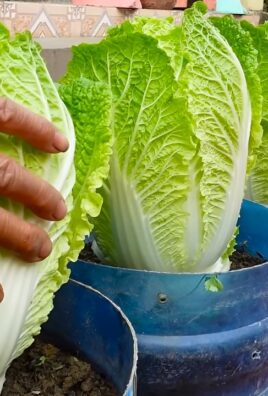
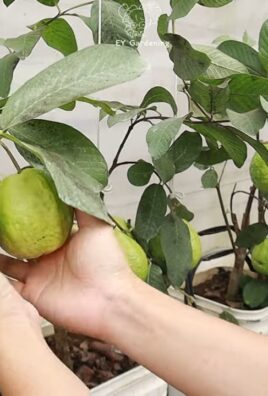
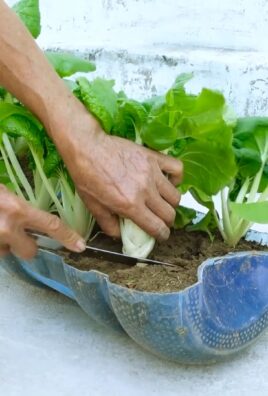
Leave a Comment